
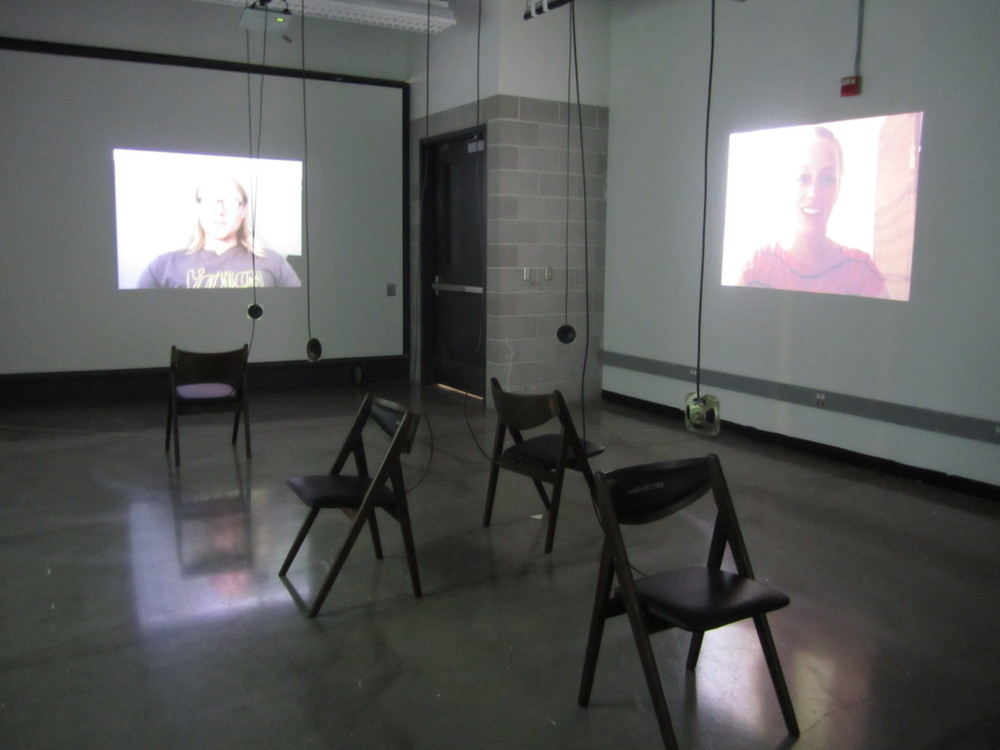

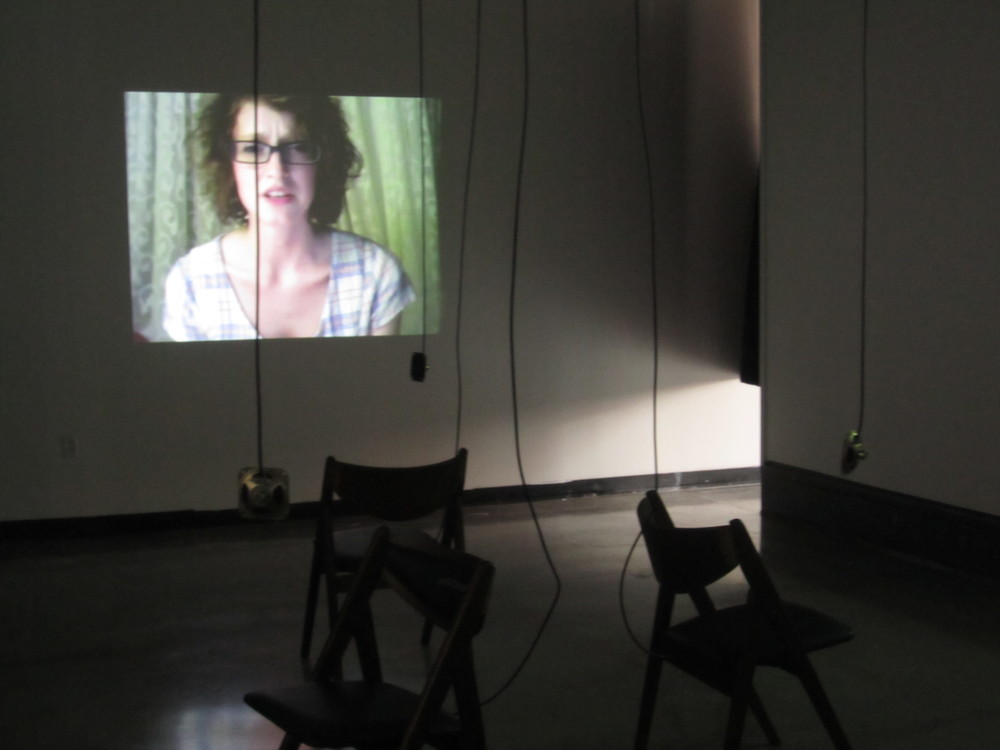


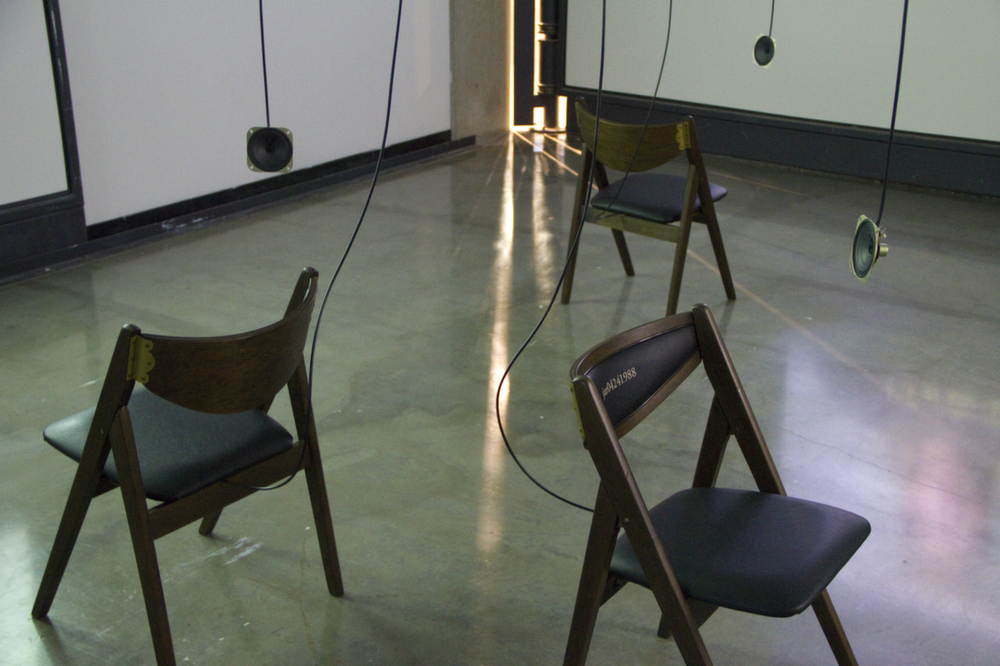
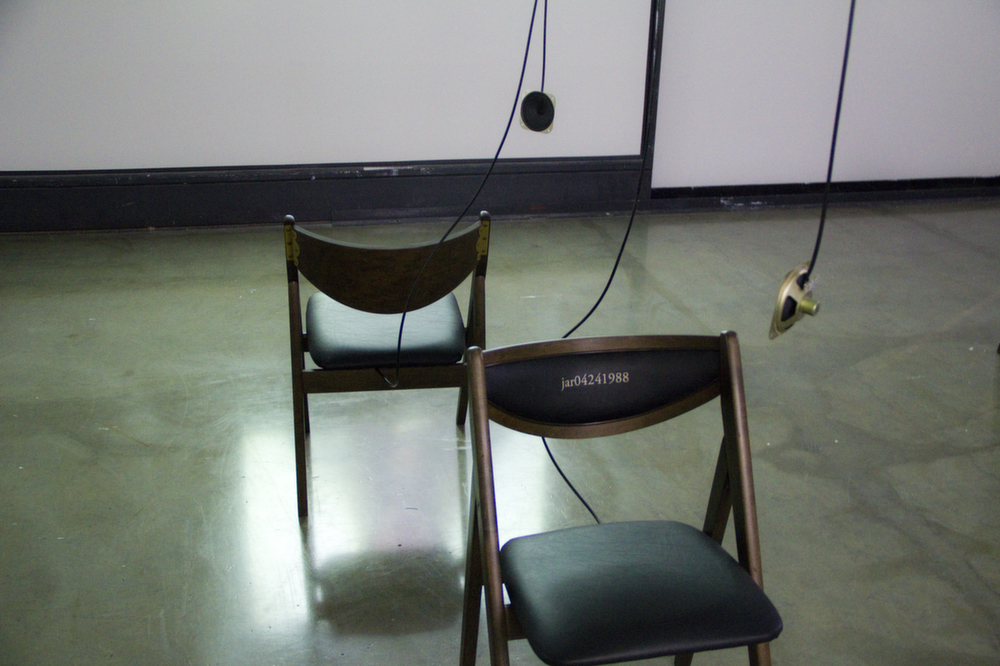
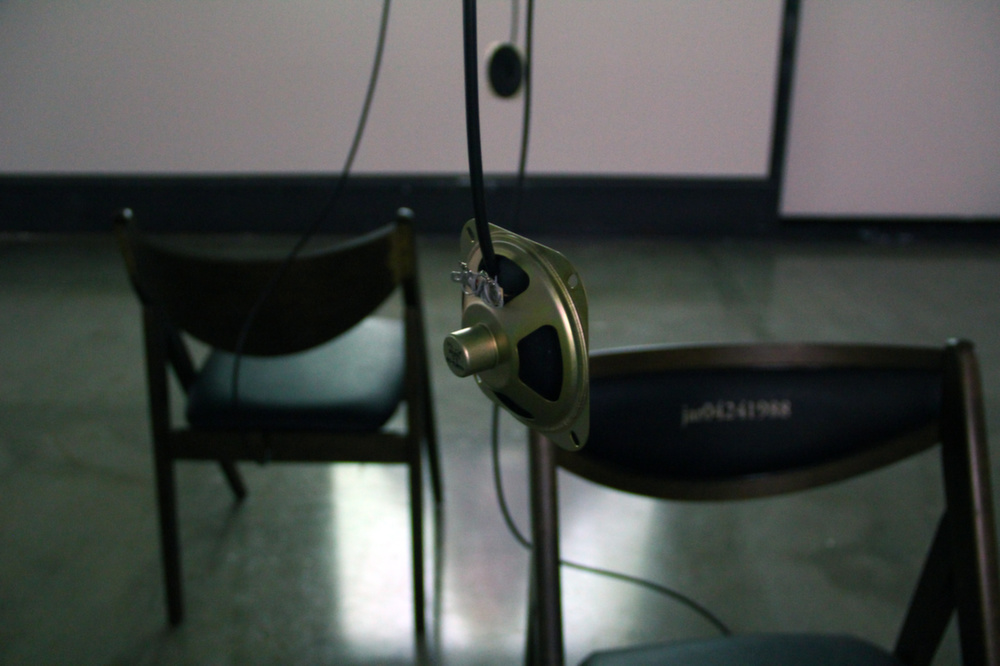
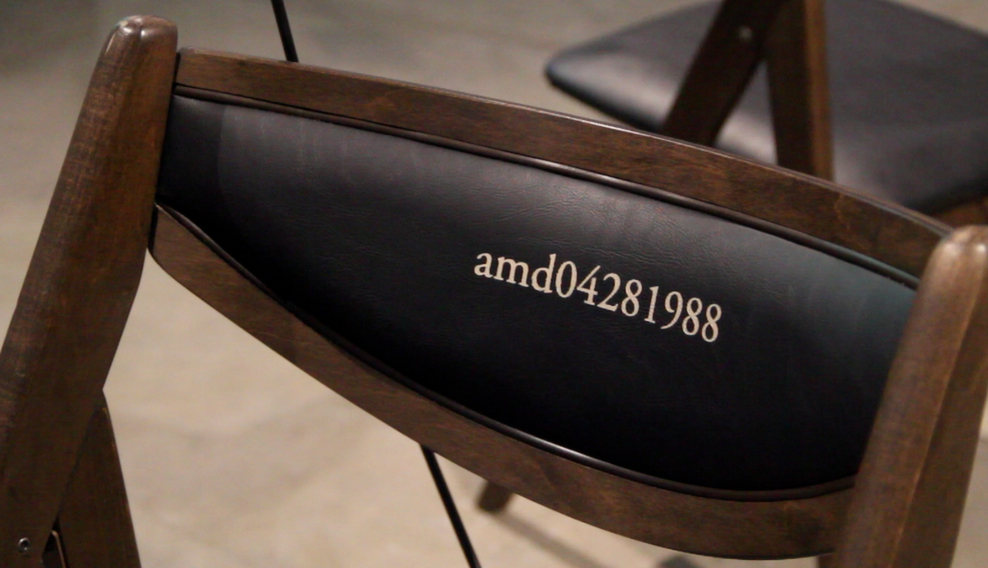
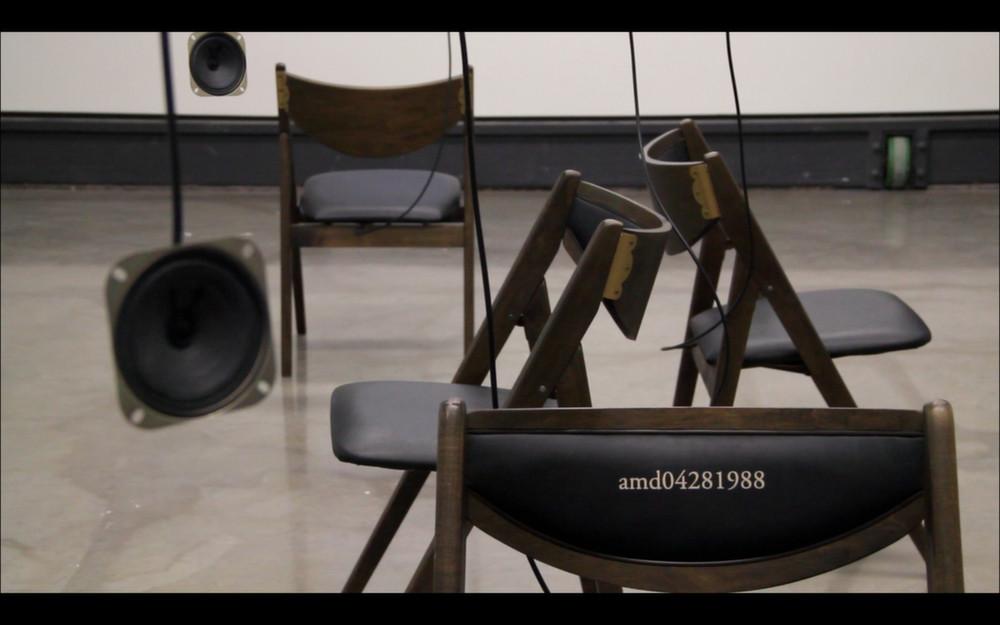
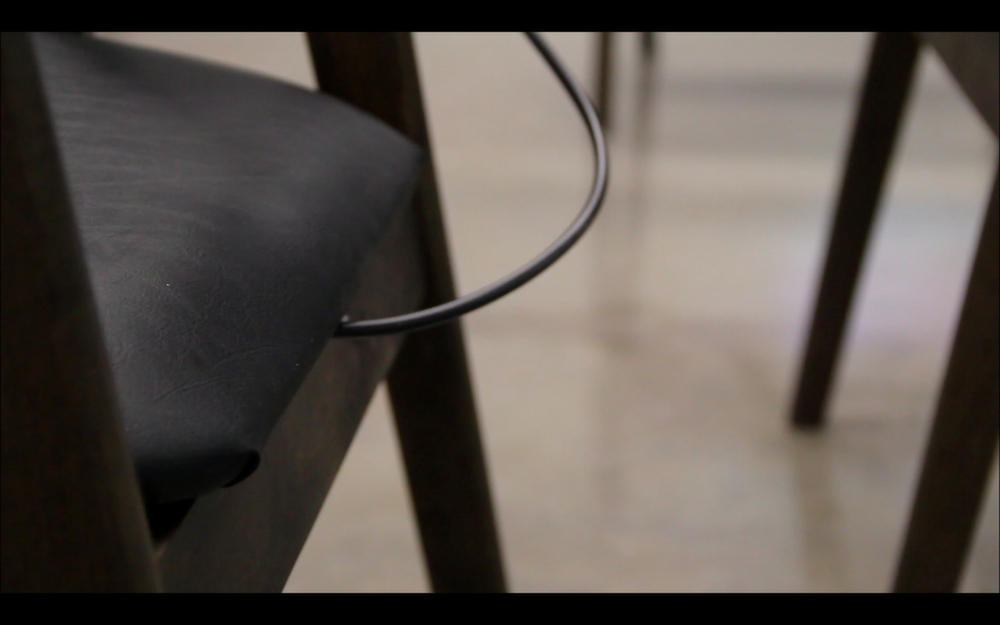
Tyler Stefanich, Re-Presented Narratives
“The resonance of his piece goes beyond this insight, into the elusiveness of relational meaning—as soon as you seize it, it vanishes.”
Re-Presented Narratives
Re-Presented Narratives roots itself in a performance from almost a year earlier in which I sat down with individual viewers, one at a time, and recalled memories of growing up. Simultaneously, five film projectors were showing looped film clips of appropriated, re-recorded home movies found on the Internet. As the films continued to loop through the recounting conversation, they began to deconstruct, and was echoed by changes / mutations taking place in the spoken narrative from individual to individual.
Re-Presented Narratives is made up of four chairs that face four large screens on four walls of a room. Small speakers dangle from cords at ear height by each chair. The chord runs from the speaker to the seat of the chair. Each screen shows individuals who experienced the performance from nearly a year ago, recounting their memories of it. The speakers’ volume is faint and audience members must hold the speaker up to their ear to hear the voices.
When people sit in a chair a circuit is created—between chair, person, speaker and story. When the circuit is activated, the legibility of sound and image become inverted and distorted. Each engagement with the piece automatically creates another a degraded copy in a series of copies, creating echoes of the original telling. The only way to hear a lucid version of the narrative is to remove one self from the circuit, by standing.
Elusive Knowledge
Ann Klefstad
Stefanich’s Re-Presented Narratives is a subtle piece that perhaps needs repeated experiences as well as, maybe, better didactics (Christ, I never thought I’d want that!) to get the point. And there is a point here.
Four chairs face four large screens on four walls of a room. Small car speakers dangle from cords at roughly ear height by each chair. A cord runs from the seat of each chair. Each screen has a moving face on it, a video of someone speaking intently to the camera—or, of course, to you. The speakers contain their voices, pitched just low enough that you have to seize the speaker and bring it to your ear—it’s like someone almost-whispering into your ear, for you only, an utterance in confidence.
Then when you sit on the chair to relax into the story, the image before you flattens into huge distorted pixels and the voice from the speaker blurs and garbles. So you stand, and all is clear. There’s discomfort in the standing, but relaxing into the chair eliminates real communion. Why?
Tyler Stefanich explains: “Nine months ago I did a performance. I took appropriated video from the internet of family movies and I rerecorded them onto Super 8 film. I showed the films, and when people came to see them I talked to them about growing up in northern Minnesota. Then, for the Art(ists on the Verge) piece, I called them, the people I had talked to. I asked them to let me post videos of them on YouTube, talking about what they remembered of the films. That’s who the people are, on the screens.
“The chairs have monograms written in gold in Garamond type, the person’s initials and their birthday. When people sit on the chairs it inverts visibility, when you sit down the image and sound gets more distorted. Every time someone engages with the piece it creates another copy in a series of copies of the videos, which get more and more distorted with each generation of copy. The only way to hear the narrative is not to be part of the circuit.”
Stefanich notes that his original performance was very confidential and intimate, and that the story changed each time he told it. That process of memory is replicated in the chain of increasingly distorted versions of the videotape evoked in this installation.
What’s the larger import of this pair of performances? It’s a subtle thing, but I think obvious— though not easy to express. This is the kind of thing that actual sensory experience can do—it can quite accurately seize on things we all recognize but have no language for, and can put these things within reach.
Stefanich alludes to the narrow perspectives we each have on our own realities, and how removing oneself from “the circuit” can clarify meanings by broadening one’s perspective. But the resonance of his piece goes beyond this insight, into the elusiveness of relational meaning—as soon as you seize it, it vanishes.
Ann Klefstad is an artist and writer in Duluth.
Artist Statement
My work focuses on the idea that as a culture, through the use of the Internet as medium and other new technologies, we are perpetually regenerating a digital semblance of the present and in turn the past. My practice as a multi-media artist revolves around the structures of private and public history, culture, memory and interpretation. There is a threshold where events and experiences no matter how vivid, become abstract and one’s view towards one’s own history becomes apathetic. My work often finds itself in the in-between spaces of these structures and roots itself in many different disciplines. By blurring boundaries between past and the present, and by fusing the old and the new, the recorded and the remembered, my work questions the originality of what is being presented and challenges perspectives we each have on our own realities.
Tyler Stefanich
Tyler Stefanich received his BFA from Minneapolis College of Art and Design in Web and Multimedia. He had the privilege to travel to the Burren College of Art to stay there (to study) for 4 months. This allowed him easy access to the rest of Europe and traveled to such places as Scotland, Germany, and Italy. His work has been shown in such exhibitions as Phase Shifts, Made at MCAD, and Spark Festival. He also has been a Jerome Semi-finalist and the recipient of the Media Art Senior Scholarship, the Northern Lights Fellowship, and the Minnesota State Arts Board Grant.